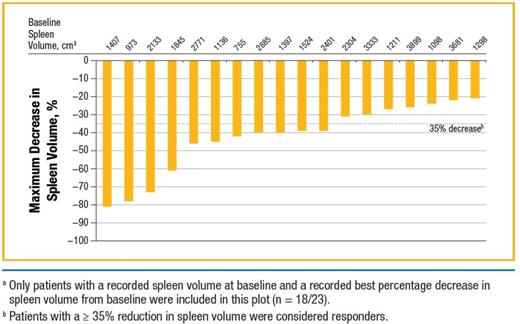Abstract
Background: Myelofibrosis (MF) is a clonal neoplastic disease resulting in bone marrow fibrosis, splenomegaly, and debilitating constitutional symptoms. The Janus kinase (JAK) pathway is often dysregulated in MF, and agents targeting this pathway have demonstrated efficacy in this disease. Ruxolitinib (RUX), a potent JAK1/JAK2 inhibitor, demonstrated superiority in spleen volume reduction, symptom improvement, and survival compared with the control arm in the phase III COMFORT-I and COMFORT-II studies. Panobinostat (PAN), a potent pan-deacetylase inhibitor (pan-DACi), inhibits JAK signaling through disruption of the interaction of JAK2 with the protein chaperone heat shock protein 90. In phase I/II studies, PAN has shown splenomegaly reduction and improvement of bone marrow fibrosis. The combination of RUX and PAN demonstrated synergistic anti-MF activity in preclinical studies. These preliminary results led to the initiation of a phase Ib study evaluating the combination of RUX and PAN in patients (pts) with MF. The updated results from the expansion phase of this trial are presented here.
Methods: Eligible pts had intermediate-1, -2, or high-risk primary MF, post-polycythemia vera MF, or post-essential thrombocythemia MF by International Prognostic Scoring System criteria, with palpable splenomegaly (≥ 5 cm below the costal margin). The primary objective was determination of the maximum tolerated dose (MTD) and/or recommended phase II dose (RPIID). Secondary objectives included safety, efficacy, and pharmacokinetics. Exploratory endpoints included assessment of improvement in bone marrow fibrosis and reduction of JAK2 V617F allele burden. The treatment schedule was RUX (5-15 mg) twice daily (bid) every day and PAN (10-25 mg) once daily 3 times per week (tiw; days 2, 4, and 6) every other week (qow) in a 28-day cycle. Following dose escalation and identification of the potential RPIID, additional pts were enrolled into the expansion phase and treated at this dose.
Results: As of March 14, 2014, a total of 61 pts were enrolled (38 escalation phase and 23 expansion phase). The median duration of exposure to PAN and to RUX was 24.6 weeks and 24.0 weeks, respectively, for pts treated in the expansion phase. Three DLTs were observed in the escalation phase (grade 4 thrombocytopenia [n = 2], grade 3 nausea [n = 1]). No MTD was reached. The RPIID was confirmed to be RUX 15 mg bid and PAN 25 mg tiw qow in May 2014. Among the 34 pts treated at the RPIID, grade 3/4 adverse events (AEs) regardless of causality included anemia (32%), thrombocytopenia (24%), diarrhea (12%), asthenia (9%), and fatigue (9%). AEs led to discontinuation in 6% of pts treated at the RPIID. Two pts treated at the RPIID died due to causes unrelated to study treatment (1 due to myocardial infarction and 1 due to progression of myelofibrosis). Among the pts treated at the RPIID, 79% showed a >50% decrease in palpable spleen length, with 100% decrease (non-palpable spleen) being observed in 53% of pts. Additionally, 48% of pts treated at the RPIID in the expansion phase achieved ≥35% reduction in spleen volume (Figure). These results are similar to those observed for spleen volume response at 24 weeks among pts who received single-agent RUX on the phase III COMFORT-I (41.9%) and COMFORT-II (32%) studies.
Conclusions: The combination of the JAK1/JAK2 inhibitor RUX and the pan-DACi PAN was well tolerated and resulted in high rates of reductions in splenomegaly in pts with intermediate- and high-risk MF. Although a relatively larger proportion of patients experienced spleen volume reductions at week 24 as compared to the COMFORT studies, the smaller sample size, shorter follow up times and potential differences in the patient populations preclude definitive comparisons. Similar to COMFORT-I and II trials, hematological AEs, specifically anemia and thrombocytopenia, were the most common AEs observed in pts treated with the combination therapy. Pts continue to be treated in the expansion phase at the RPIID. Updated safety, efficacy, and exploratory analyses on bone marrow fibrosis, JAK V617F allele burden, and biomarkers, including cytokines, will be presented.
Kiladjian:Novartis: Honoraria, Research Funding, Speakers Bureau; Shire: Membership on an entity's Board of Directors or advisory committees; AOP Orphan: Honoraria, Research Funding. Heidel:Novartis: Honoraria, Membership on an entity's Board of Directors or advisory committees. Vannucchi:Novartis: Membership on an entity's Board of Directors or advisory committees, Research Funding, Speakers Bureau. Ribrag:Celgene: Consultancy; Pharmamar: Consultancy; Epizyme: Research Funding; Bayer: Consultancy, Research Funding; Servier: Consultancy, Honoraria, Research Funding. Conneally:Novartis: Honoraria, Membership on an entity's Board of Directors or advisory committees, Speakers Bureau; BMS: Honoraria, Speakers Bureau; Pfizer: Honoraria, Membership on an entity's Board of Directors or advisory committees, Speakers Bureau. Kindler:Novartis: Consultancy. Acharyya:Novartis: Employment. Gopalakrishna:Novartis: Employment. Ide:Novartis: Employment, Equity Ownership. Loechner:Novartis: Employment. Mu:Novartis: Employment. Harrison:Novartis: Consultancy, Honoraria, Research Funding, Speakers Bureau; Sanofi: Consultancy, Honoraria; CTI: Consultancy, Honoraria; Gilead: Honoraria; SBio: Consultancy; Shire: Speakers Bureau.
Author notes
Asterisk with author names denotes non-ASH members.


